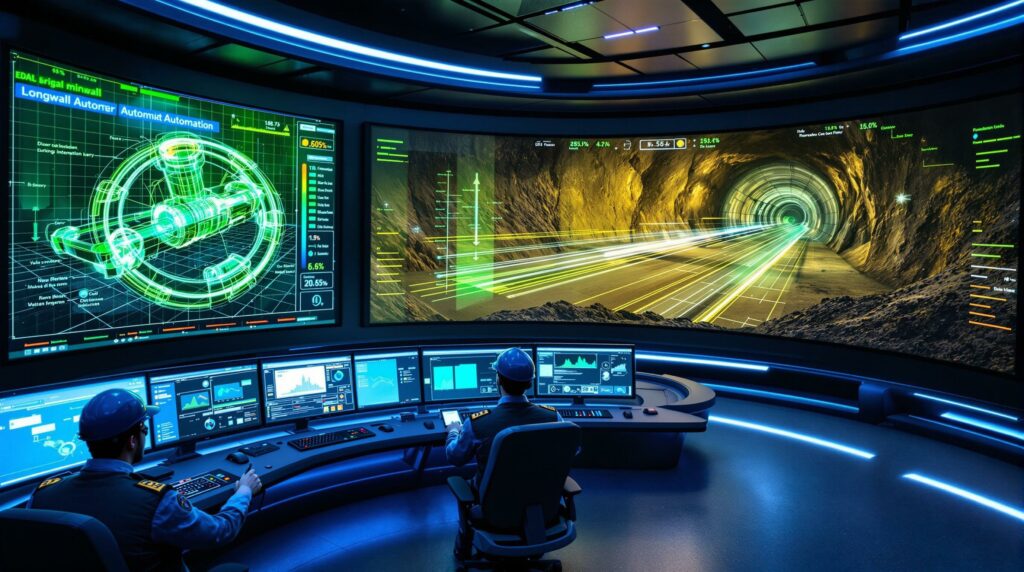What Is Longwall Command and Control in Underground Mining?
Longwall Command and Control (LCC) represents a significant technological leap in underground mining operations, transforming how coal extraction is managed and executed. This advanced system converts traditional shearer operations into fully digital assets that can be remotely controlled, diagnosed, and optimized from surface-based operation centers. By eliminating the need for operators to be physically present in hazardous underground environments, LCC technology marks a watershed moment in mining safety and efficiency.
The core innovation behind longwall command and control lies in its ability to translate complex mining operations into intuitive digital interfaces. These systems provide comprehensive visualization of underground activities while maintaining precise control over cutting equipment. Rather than requiring operators to navigate dangerous underground conditions, LCC creates a protected environment where mining professionals can apply their expertise without exposure to coal dust, noise, vibration, and other hazards inherent to subsurface operations.
"The transition to surface-controlled longwall operations follows the natural progression we've already witnessed across the mining industry. Just as haul trucks, drill rigs, and crushing circuits now operate successfully from hundreds of kilometers away, underground shearer automation represents the next frontier in mining technology." – Australian Mining, August 2025
Modern LCC systems incorporate multiple redundancies and fail-safe mechanisms to ensure uninterrupted operation. These include continuous communication monitoring, automatic safety protocols, and comprehensive equipment health diagnostics. The technological architecture balances cutting-edge capabilities with robust reliability – a crucial consideration for critical mining operations where downtime directly impacts production and profitability.
Understanding Modern Shearer Automation Technology
The evolution of shearer automation represents a remarkable journey from basic mechanization to sophisticated digital control systems. Early longwall mining relied heavily on manual operations, with miners working in dangerous proximity to cutting equipment. Progressive improvements in remote control technology gradually moved operators further from hazards, but still required underground presence. Today's advanced systems have completed this evolution by bringing control capabilities entirely to the surface.
From Underground Radio Control to Surface Operations
Traditional shearer operation typically involved radio handsets (commonly known as HHX radios) that allowed miners to control equipment from a short distance within the same underground space. While this offered some protection from immediate cutting hazards, it still exposed operators to dust, noise, and potential roof collapse risks. Modern automation technology eliminates these exposures by relocating control functions to surface-based operation centers with enhanced environmental controls and ergonomic workstations.
Key Components of Advanced Automation Systems
Modern longwall automation systems integrate several critical technologies:
- Secure network infrastructure for reliable data transmission between surface and underground equipment
- Digital twinning capabilities that provide accurate visual representation of underground conditions
- Intuitive control interfaces designed to mirror familiar operator experiences
- Continuous monitoring systems for both equipment health and operational parameters
- Automated safety protocols that engage instantaneously when anomalies are detected
These systems transform the operator experience while preserving the tactile control elements that experienced miners rely on. This balance between innovation and familiarity has proven essential for successful implementation and workforce adoption.
Safety and Productivity Enhancements
The relocation of operators from underground environments to surface control rooms delivers multiple benefits beyond immediate hazard reduction. Surface-based control provides superior lighting, reduced noise levels, improved air quality, and ergonomic workstations that combat fatigue. These environmental improvements extend effective working hours while reducing long-term health impacts commonly associated with underground mining roles.
How Komatsu's Longwall Command and Control Works
Komatsu's Longwall Command and Control (LCC) system represents one of the industry's most comprehensive approaches to AI in mining automation. This sophisticated platform leverages web-based architecture to create a seamless connection between surface operations and underground equipment. The system's design prioritizes reliability, security, and operator familiarity – three critical factors for successful mining automation.
Web-Based Control Architecture
The foundation of Komatsu's LCC system is its advanced web-based control platform. This architecture allows operators to access complete shearer functions through standard computers or rugged Android tablets, providing flexibility in control station setup. The web interface eliminates the need for specialized control hardware while maintaining comprehensive functionality.
Secure Communication Protocols
Data security represents a critical consideration in mining automation. Komatsu's system employs secure Modbus-TCP links with continuously monitored "heartbeat" signals that verify consistent communication. If this heartbeat signal interrupts for any reason, automatic safety shutdown mechanisms engage immediately, preventing uncontrolled equipment operation. This multi-layered approach to communication security ensures that equipment remains in a safe state even during unexpected network disruptions.
Integration with Existing Infrastructure
One of the most significant advantages of Komatsu's approach is its compatibility with existing mining infrastructure. The system works with both new shearers and retrofitted equipment, allowing mines to implement automation incrementally without wholesale equipment replacement. This compatibility extends to integration with existing modern mine planning systems, production monitoring platforms, and maintenance scheduling software.
Real-Time Equipment Monitoring
Beyond basic operational control, Komatsu's LCC system provides comprehensive equipment health monitoring. Operators can access detailed diagnostic information including motor temperatures, hydraulic pressures, cutting forces, and positional data. This wealth of information enables proactive maintenance planning and early identification of potential equipment issues before they result in costly downtime.
Benefits of Remote Shearer Operation
The transition to remote shearer operation delivers multiple advantages that extend far beyond basic automation. These benefits address longstanding challenges in underground mining while creating new opportunities for operational excellence and workforce development.
Enhanced Operator Safety
The most immediate benefit of remote operation is the removal of personnel from hazardous underground environments. By relocating operators to surface control rooms, mines eliminate exposure to:
- Respirable coal dust and silica particles
- Noise-induced hearing damage
- Vibration-related injuries
- Confined space hazards
- Roof fall and rib roll risks
- Proximity to high-powered cutting equipment
This dramatic reduction in exposure to occupational hazards represents one of the most significant safety advancements in modern mining history.
Improved Ergonomics and Working Conditions
Surface-based control rooms provide substantially improved working environments compared to underground operations. These facilities feature:
- Controlled temperature and humidity
- Proper lighting conditions
- Reduced ambient noise
- Ergonomic seating and workstations
- Ready access to facilities and amenities
- Clear communication capabilities
These improvements reduce operator fatigue and stress while extending productive working hours. The enhanced working conditions also contribute to improved job satisfaction and retention – critical factors in an industry facing significant workforce challenges.
Comprehensive Data Visibility
Remote operation centralizes data collection and visualization, providing operators and supervisors with unprecedented insight into mining operations. This expanded visibility enables:
- Real-time production monitoring and optimization
- Immediate identification of cutting issues
- Comprehensive equipment health tracking
- Data‐driven operations
- Historical performance analysis for continuous improvement
The wealth of information available through remote operation creates opportunities for ongoing optimization that simply cannot exist with traditional underground control methods.
Reduced Environmental Risk Exposure
Beyond immediate safety benefits, remote operation reduces long-term health risks associated with underground mining environments. Operators no longer face chronic exposure to diesel particulate matter, coal dust, silica, noise, and vibration – factors linked to occupational diseases including coal workers' pneumoconiosis, silicosis, noise-induced hearing loss, and vibration-related disorders.
Key Features of Soft Remote Operations
Komatsu pioneers underground shearer automation through its soft remote operation technology, creating a seamless transition between traditional and remote control methods. This approach maintains operational familiarity while delivering the safety and efficiency benefits of surface-based control.
Digital Mirroring of Traditional Control Functions
The system's most distinctive feature is its ability to digitally replicate the functionality of traditional hand-held HHX radios. This mirroring allows operators to:
- Start motors and auxiliary systems
- Control tramming functions for shearer positioning
- Adjust cutting drum ranges and speeds
- Acknowledge roof support control prompts
- Monitor cutting parameters in real-time
This familiar operational model significantly reduces the learning curve for experienced operators while maintaining the intuitive control methodology they've developed through years of underground experience.
Secure Communication Architecture
Reliable and secure communication forms the foundation of effective remote operations. Komatsu's system employs:
- Redundant network pathways to prevent communication loss
- Secure Modbus-TCP protocols for data transmission
- Continuous heartbeat monitoring to verify connection status
- Automatic safety protocols when communication interrupts
- Encrypted data transmission to prevent unauthorized access
These multiple security layers ensure that equipment remains under positive control at all times, with automatic safety engagement when communication challenges arise.
Safety-First Operational Design
Safety considerations permeate every aspect of the soft remote system design. The platform incorporates:
- Automatic shutdown protocols for communication interruptions
- Visual confirmation of equipment status and positioning
- Redundant command verification to prevent unintended operations
- Clear visualization of nearby personnel and equipment
- Emergency override capabilities for critical situations
These integrated safety features create multiple layers of protection that exceed traditional underground control capabilities.
Intuitive Interface Design
The user interface represents a critical component of successful remote operation. Komatsu's system features:
- Familiar control layouts that mirror traditional equipment
- Clear visual representations of underground conditions
- Intuitive command sequences for common operations
- Customizable interface elements to match operator preferences
- Comprehensive but uncluttered information displays
This thoughtful interface design balances information availability with operational clarity, preventing the information overload that can compromise effective decision-making.
How Does Height-Based Pitch Steering Revolutionize Mining?
Height-Based Pitch Steering (HBPS) represents one of the most significant innovations in modern longwall mining, transforming how operators interact with cutting equipment. This advanced system translates complex technical requirements into intuitive operational commands, dramatically simplifying floor control while improving cutting precision.
Intuitive Operator Instructions
Traditional pitch steering systems require operators to think in technical terms like degrees and pass-counts – concepts that don't directly connect to the practical goals of mining operations. HBPS transforms this approach by allowing operators to communicate in straightforward, goal-oriented language. Instead of complex technical specifications, operators can simply instruct the system to "lift the floor 75mm through shields 25-33" – a natural expression of the actual mining objective.
This intuitive communication model leverages the operator's practical knowledge while eliminating the need for mental translation between objectives and technical commands. The result is more direct control, reduced operator cognitive load, and improved cutting precision.
Automated Floor Drum Positioning
The core functionality of HBPS focuses on automated floor drum control. The system:
- Positions the floor drum at a height that maintains a preconfigured pitch angle of the pans
- Automatically adjusts cutting parameters based on seam conditions
- Maintains consistent floor profiles across the full face width
- Implements precise transitions between different floor elevations
- Reduces unnecessary floor cutting that can compromise stability
This automated approach ensures consistent floor conditions while reducing operator workload and equipment stress. The precision control of floor profiles contributes to improved roof stability, conveyor efficiency, and overall longwall performance.
Integration with Gate Road Survey Data
HBPS achieves its remarkable precision through integration with existing mine planning information. The system:
- Incorporates gate road survey data for accurate seam targeting
- Utilizes geological information to anticipate seam variations
- Plans cuts based on comprehensive 3D geological modelling
- Implements gradual transitions between different mining zones
- Maintains proper horizon control throughout the extraction process
This integration of planning data with cutting control ensures that mining operations follow the optimal extraction path while maintaining appropriate floor and roof profiles.
Productivity Through Intelligent Algorithms
Beyond basic automation, HBPS employs sophisticated algorithms that optimize cutting parameters throughout the mining process. These intelligent systems:
- Implement automated tapering for smooth transitions
- Optimize cutting rates based on material hardness
- Adjust drum positions to accommodate seam variations
- Balance cutting speed with equipment stress limitations
- Maintain consistent coal loading onto the armored face conveyor
The cumulative effect of these optimizations is improved productivity, reduced equipment wear, and more consistent product quality – all while simplifying the operator experience.
Real-World Implementation of Automated Shearer Technology
The successful deployment of automated shearer technology depends on thoughtful implementation strategies that address both technical and human factors. Komatsu's approach emphasizes collaborative development, comprehensive testing, and seamless integration with existing operations.
Collaborative Development Approach
Effective automation systems require deep integration of engineering expertise with practical operational knowledge. Komatsu employs a collaborative development model that:
- Incorporates direct operator input throughout the design process
- Prioritizes features based on actual mining challenges
- Balances technological capability with operational practicality
- Preserves familiar operational patterns while enhancing capabilities
- Ensures intuitive interfaces that leverage existing operator skills
This collaborative approach ensures that automation technology addresses real-world mining challenges rather than imposing theoretical solutions that may not align with operational realities.
Structured Feedback Channels
Continuous improvement represents a core principle in Komatsu's implementation methodology. As Shane Cooling, Komatsu engineering manager control and automation explains: "Our customers log their ideas and pain points through a structured voice-of-the-customer channel. Engineering then prototypes the highest value fixes on an offline test rig, validating each tweak."
This formalized feedback process ensures that:
- Operational challenges receive appropriate engineering attention
- Feature prioritization reflects actual mining needs
- Solutions undergo thorough validation before deployment
- Users maintain ownership in the development process
- Systems continuously evolve to address emerging requirements
The structured approach balances rapid response to operational needs with thorough validation that prevents unintended consequences.
Rigorous Testing Protocols
Automation technology must meet exceptionally high reliability standards in the mining environment. Komatsu employs comprehensive testing methodologies including:
- Offline test rigs for initial feature validation
- Simulated operational testing under various conditions
- Controlled field trials in actual mining environments
- Progressive implementation of capabilities
- Comprehensive documentation of performance metrics
This exhaustive testing regime ensures that new features and capabilities perform as expected before affecting production operations.
Zero-Disruption Deployment
The implementation of new technology must not compromise ongoing production. Komatsu addresses this requirement through carefully planned deployment strategies. Cooling notes that updates "typically [occur] during a planned maintenance window, ensuring zero disruption to cutting hours."
This zero-disruption approach:
- Aligns technology updates with existing maintenance schedules
- Minimizes production impacts during implementation
- Ensures comprehensive pre-deployment preparation
- Provides appropriate training ahead of feature activation
- Maintains operational continuity throughout the technology lifecycle
By integrating technology deployment with established maintenance practices, mines can adopt advanced automation without sacrificing short-term production goals.
Comparing Traditional vs. Automated Shearer Control
The transition from traditional to automated shearer control represents a fundamental shift in operational methodology. Understanding the differences between these approaches helps mining operations anticipate implementation challenges and maximize benefits from automation technology.
Operator Experience Differences
Traditional and automated control systems create distinctly different operator experiences:
| Aspect | Traditional Control | Automated Control |
|---|---|---|
| Physical Environment | Underground conditions with dust, noise, and vibration | Climate-controlled surface facility with ergonomic workstations |
| Sensory Input | Direct physical perception of equipment operation | Digital representation through screens and data feeds |
| Control Interface | Physical radio handset with limited functions | Computer or tablet interface with comprehensive capabilities |
| Information Access | Limited to visible conditions and basic indicators | Comprehensive data from multiple sensors and systems |
| Communication | Often challenging due to noise and distance | Clear voice communication in control room environment |
| Shift Duration | Limited by environmental stress and fatigue | Extended by improved working conditions |
While automated systems provide substantial environmental improvements, they require operators to transition from direct physical perception to digital information interpretation – a significant cognitive adjustment.
Learning Curve Considerations
The transition to automated control requires thoughtful training approaches that address both technical and psychological factors:
- Experienced operators must adapt from physical to digital operational models
- New operators need comprehensive training in system capabilities and limitations
- Both groups require understanding of automated system behaviors and response patterns
- Training must address both normal operations and exception handling
- Operators need practice in interpreting digital information effectively
Successful implementation requires training programs that acknowledge the distinct skill sets required for effective remote operation while building on existing operational knowledge.
Production Efficiency Comparisons
Automated systems offer multiple efficiency advantages compared to traditional approaches:
- Reduced shift changes due to improved operator working conditions
- Consistent operation unaffected by underground environmental factors
- Precise cutting control through automated systems
- Comprehensive data visibility for immediate optimization
- Reduced equipment damage through automated protection systems
These efficiency improvements typically emerge progressively as operators become comfortable with automated systems and begin leveraging their full capabilities.
Maintenance Implications
The shift to digital control systems creates both challenges and opportunities for maintenance operations:
- New diagnostic capabilities provide early warning of developing issues
- Digital systems require different maintenance skill sets than traditional equipment
- Software updates become a regular component of maintenance activities
- Network infrastructure becomes a critical maintenance consideration
- Data analysis capabilities enable predictive maintenance approaches
Maintenance teams must develop new capabilities to support digital systems while leveraging the enhanced diagnostic information these systems provide.
The Future of Underground Mining Automation
The implementation of shearer automation represents just one component of a broader technological evolution in underground mining. This transformation will continue to accelerate as digital technologies mature and mining operations embrace comprehensive automation strategies.
Integration with Broader Mine Automation
Shearer automation will increasingly integrate with other automated systems to create comprehensive digital mining environments. This integration will connect:
- Automated conveyor systems for coordinated material handling
- Ventilation-on-demand systems that respon
Want to Identify the Next Major Mineral Discovery?
Discovery Alert's proprietary Discovery IQ model provides instant notifications on significant ASX mineral discoveries, transforming complex data into actionable insights for investors seeking an edge in the market. Visit our discoveries page to explore how historic mineral discoveries have generated substantial returns and begin your 30-day free trial today.




